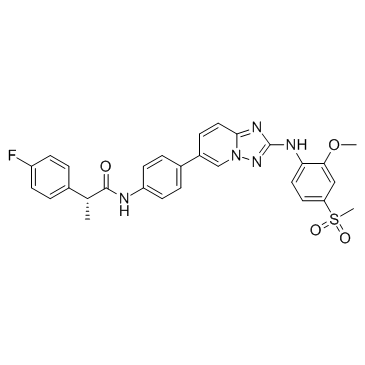| Cas No.: | 1443763-60-7 |
| Chemical Name: | Empesertib |
| Synonyms: | BAY1161909; BAY-1161909; BAY 1161909; Empesertib, Mps1-IN-5. |
| SMILES: | FC1C=CC(C(C(=O)NC2C=CC(C3C=CC4N(N=C(N=4)NC4C(OC)=CC(S(=O)(=O)C)=CC=4)C=3)=CC=2)C)=CC=1 |
| Formula: | C29H26FN5O4S |
| M.Wt: | 559.616 |
| Purity: | >98% |
| Sotrage: | 2 years -20°C Powder, 2 weeks 4°C in DMSO, 6 months -80°C in DMSO |
| Publication: | [1]. SCHULZE, Volker, et al. PRODRUG DERIVATIVES OF SUBSTITUTED TRIAZOLOPYRIDINES. WO2014198647A2 |
| Description: | Empesertib(BAY 1161909) is a potent Mps1 inhibitor, with an IC50 of < 1 nM. |
| Target: | Mps1:1 nM (IC50) |
| In Vitro: | BAY 1161909 is a potent Mps1 inhibitor, with an IC50 of < 1 nM. BAY 1161909 also shows anti-tumor effect, suppressing the proliferation of Hela cells, with an IC50 of < 400 nM[1]. |
| Kinase Assay: | N-terminally GST-tagged human full length recombinant Mps-1 kinase is used. As substrate for the kinase reaction a biotinylated peptide of the amino-acid sequence PWDPDDADITEILG is used. For the assay 50 nL of a 100-fold concentrated solution of the test compounds (BAY 1161909, etc.) in DMSO is pipetted into a black low volume 384 well microtiter plate, 2 μL of a solution of Mps-1 in assay buffer [0.1 mM sodium-ortho-vanadate, 10 mM MgCl2, 2 mM DTT, 25 mM Hepes pH 7.7, 0.05% BSA, 0.001 % Pluronic F-127] are added and the mixture is incubated for 15 min at 22°C to allow pre-binding of the test compounds to Mps-1 before the start of the kinase reaction. Then the kinase reaction is started by the addition of 3 μL of a solution of 16.7 adenosine-tri-phosphate and peptide substrate in assay buffer and the resulting mixture is incubated for a reaction time of 60 min at 22°C. The concentration of Mps-1 in the assay is adjusted to the activity of the enzyme lot and is chosen appropriate to have the assay in the linear range, typical enzyme concentrations are in the range of about 1 nM (final cone, in the 5 μL assay volume). The reaction is stopped by the addition of 3 μL of a solution of HTRF detection reagents (100 mM Hepes pH 7.4, 0.1 % BSA, 40 mM EDTA, 140 nM Streptavidin-XLent, 1 .5 nM anti-phospho(Ser/Thr)-Europium-antibody[1]. |
| Cell Assay: | Cultivated tumor cells are plated at a density of 5000 cells/ well (MCF7, DU145, HeLa-MaTu-ADR), 3000 cells/well (NCI-H460, HeLa-MaTu, HeLa), or 1000 cells/well (B16F10) in a 96-well multititer plate in 200 μL of their respective growth medium supplemented 10% fetal calf serum. After 24 hours, the cells of one plate (zero-point plate) are stained with crystal violet, while the medium of the other plates is replaced by fresh culture medium (200 μL), to which the test substances (BAY 1161909, etc.) are added in various concentrations (0 μM, as well as in the range of 0.01-30 μM; the final concentration of the solvent DMSO is 0.5%). The cells are incubated for 4 days in the presence of test substances. Cell proliferation is determined by staining the cells with crystal violet: the cells are fixed by adding 20 μL/measuring point of an 11% glutaric aldehyde solution for 15 minutes at room temperature. After three washing cycles of the fixed cells with water, the plates are dried at room temperature. The cells are stained by adding 100 μL/measuring point of a 0.1% crystal violet solution (pH 3.0). After three washing cycles of the stained cells with water, the plates are dried at room temperature. The dye is dissolved by adding 100 μL/measuring point of a 10% acetic acid solution. The IC50 values are determined by means of a 4 parameter fit. The compounds A1 (BAY 1161909), A2, A3, A4 and A5 are characterized by an IC50 determined in a HeLa-MaTu-ADR cell proliferation assay[1]. |
| References: | [1]. SCHULZE, Volker, et al. PRODRUG DERIVATIVES OF SUBSTITUTED TRIAZOLOPYRIDINES. WO2014198647A2 |

 DC Chemicals' products qualify for U.S. tariff exemptions. We guarantee no price increases due to customs duties and maintain stable supply, continuing to deliver reliable research solutions to our American clients.
DC Chemicals' products qualify for U.S. tariff exemptions. We guarantee no price increases due to customs duties and maintain stable supply, continuing to deliver reliable research solutions to our American clients.





















